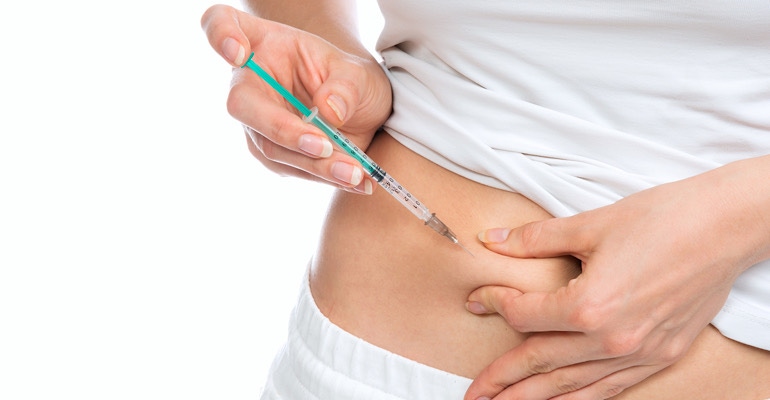An expert look at issues driving up the demand for self-administration drug-delivery devices that combine pre-filled safety-engineered aspects.

Staff shortages, financial pressure and a growing ageing population are the three key drivers pushing forwards the current trend of self-administration of injections for patients suffering from chronic illnesses. By 2060, there will be over 95 million Americans aged 65 and over – nearly double today’s number- and with old age comes greater likelihood of chronic illnesses.1
Hospitals have taken matters into their own hands by ‘outsourcing’ this low-risk medical procedure that drains both precious healthcare professionals’ time and limited space – and handing the baton over to home carers or patients themselves who are able to perform such drug injections in the comfort of their own homes. However, even healthcare professionals carrying out injections within hospital settings continue to be subjected to the risk of needlestick injuries with potentially contaminated needles. It is therefore of utmost importance that the safety of the medical devices being used for injection, as well as the best practices surrounding their usage, be strengthened both within traditional healthcare environments and these newly emerging sites for home-administration. Up until now, most drug-delivery devices for injection have been designed for healthcare professionals as their primary users, but manufacturers will increasingly need to adjust their products to a new breed of clientele, including both patients and home-based carers.
Self-Administration Trend Drivers
Part of the underlying reason self-administration has increased in recent years is the wave of biological therapies entering the market, which are specifically suited to treatment by subcutaneous injection for patients with chronic diseases such as multiple sclerosis or rheumatoid arthritis given that they require frequent and regular injections. When not required to make frequent trips to the clinic and rely on the expertise of nurses, patients are empowered to play a bigger part in their own treatment and disease management, which they can more easily fit around their personal lives.
Sharps injuries from unprotected needles have certainly declined since the introduction of the US Needlestick Safety and Prevention Act (NSPA) almost twenty years ago, yet we continue to see an average of 1,000 injuries reported every day in US hospitals.2 Given that an estimated 50% of non-hospital settings are deemed non-compliant with Occupational Safety and Health Administration (OSHA)3 self-administrating patients are at a much higher risk of contracting a needlestick injury. This risk extends to their family members and other residents if improper safety measures and disposal techniques are applied. With non-users being far less likely to be aware of the contamination of a device, or even know the risks presented by contaminated devices more generally, self-administration leaves non-patients particularly vulnerable to such exposures.
Designing with Self-Administration in Mind
While the general population can be made more aware of these risks, manufacturers can also make a huge difference through device design and should accommodate their devices to patient capabilities. Safety devices should be intuitive and easy to use, requiring minimal effort to activate and inject. Most importantly, manufacturers must be sure to integrate needlestick prevention features into their devices. For example, devices with hollow-bore needles or syringes which retain an exposed needle after patient use present a heightened risk, while retracting and needle shielding mechanisms are much safer.4 Given that safer features of drug delivery devices can reportedly reduce needlestick injuries and contaminations by up to 80%5 it is no surprise then that the safety prefilled syringe market has taken off in recent years. In 2018, global spending on safety syringes reached $772 million, and this is expected to grow an impressive 8.1% CAGR, reaching $1.137 billion by 2023.6 Going one step further, pre-filled safety syringes meet these safety requirements while also having the added benefit of reducing the risk of dosage errors. These instruments not only substantially reduce risks but are especially well-suited to a growing self-injecting patient population.
As self-administration continues to take off, it is important to consider the risks that come with exporting potential needle exposure outside of their typical clinical setting. In some ways, this trend acts as a useful reminder and a prompt to solidify the safety foundations across all healthcare systems and locations. By making self-administration a viable alternative and enabling older and less dextrous patients to securely operate the device without assistance, pre-filled safety syringes and autoinjectors are providing users with a level of independence that would otherwise be unavailable to them were they reliant on hospital staff for medication, while also reducing the risks associated with unsupervised care. With homecare successfully reducing pressure on healthcare systems, manufacturers will play a key role in ensuring the continued upward trajectory of self-administration by continually adapting their drug delivery devices to the evolving healthcare landscape.
1 Population Reference Bureau (PRB), Fact Sheet: Aging in the United States, July 2019, https://www.prb.org/aging-unitedstates-fact-sheet/
2 OSHA, http://www.osha.gov/SLTC/etools/hospital/hazards/sharps/sharps.html
3 Medical Devices: Evidence and Research, Vol 10, Clinical, economic, and humanistic burden of needlestick injuries in healthcare workers, 2 May 2017
4 World Health Organization, Needlestick Safety and Prevention, Independent Study
5 World Health Organization, Needlestick Safety and Prevention, Independent Study
6 Market Data Forecast, Safety Syringes Market by Technology, Oct 2018
About the Author(s)
You May Also Like




